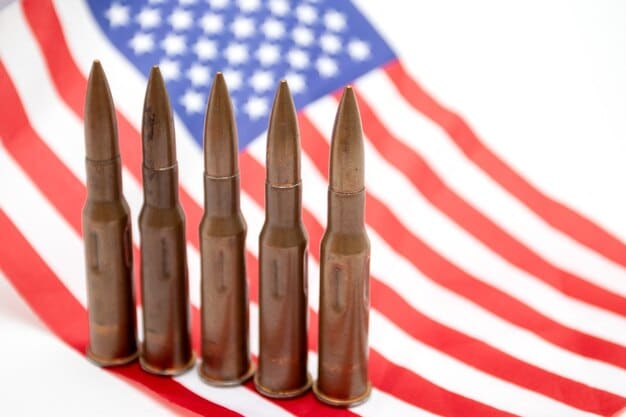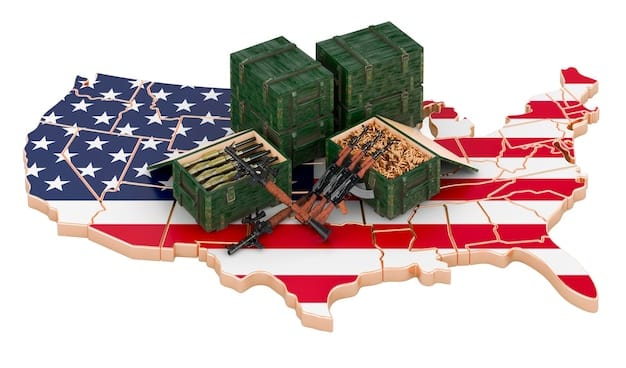Analyzing the Political Divide on Gun Control: Finding Common Ground in 2025

Analyzing the political divide on gun control legislation in 2025 reveals deep-seated disagreements on the Second Amendment, public safety, and the role of government, making common ground elusive but crucial for effective policy solutions.
The debate surrounding gun control in the United States is one of the most polarizing issues in contemporary politics. Analyzing the political divide on gun control legislation: Can common ground be found in 2025? is a question that resonates deeply as the nation grapples with persistent gun violence.
Understanding the Deep Roots of the Gun Control Debate
The issue of gun control is not new. It has been a contentious subject in American politics for decades. Understanding its historical context is crucial for grasping the current political landscape.
The Second Amendment of the United States Constitution guarantees the right to bear arms, but its interpretation has been a subject of intense debate. Different interpretations fuel the divide.
Historical Context of Gun Control Legislation
Throughout history, various gun control measures have been introduced and debated, often in response to specific events or periods of heightened concern about public safety.
- The National Firearms Act of 1934: One of the earliest federal gun control laws, it imposed taxes and regulations on certain types of firearms.
- The Gun Control Act of 1968: Enacted in response to the assassinations of President John F. Kennedy and Martin Luther King Jr., it focused on prohibiting certain people from purchasing firearms and regulating interstate gun sales.
- The Brady Handgun Violence Prevention Act of 1993: Established a background check system for firearm purchases.
These laws reflect ongoing efforts to balance Second Amendment rights with public safety concerns.

Recent years have seen renewed calls for stricter gun control measures due to the increasing frequency and severity of mass shootings.
The debate over gun control is deeply rooted in differing interpretations of the Second Amendment. These differing views have led to gridlock.
The Core Arguments: Sides of the Divide
The debate over gun control is characterized by two primary viewpoints, each with their own set of arguments, values, and objectives.
Each side holds strong beliefs, making compromise challenging. A closer look reveals the nuances of each side.
Pro-Gun Rights Arguments
The core argument from the pro-gun rights perspective revolves around the Second Amendment.
- Protection: Many gun rights advocates believe that firearms are essential for self-defense and the protection of their families.
- Deterrence: Some argue that widespread gun ownership deters crime.
- Sport and Recreation: Many individuals participate in hunting, shooting sports, and other recreational activities involving firearms.
These advocates believe stricter gun laws infringe upon their constitutional rights and limit their ability to defend themselves.
Pro-gun groups often emphasize responsible gun ownership and training as key components in preventing gun violence.
Gun Control Advocacy Arguments
Gun control advocates emphasize the need to reduce gun violence and enhance public safety through stricter regulations.
They argue for measures such as universal background checks, bans on assault weapons, and red flag laws to prevent firearms from falling into the wrong hands.
- Public Safety: Prioritizing measures to reduce gun-related deaths and injuries.
- Reducing Crime: Implementing policies to decrease gun violence in communities.
- Mental Health: Supporting restrictions to prevent individuals with mental health issues from acquiring guns.
Many studies suggest that stricter gun control laws are associated with lower rates of gun violence.
The debate is complex and requires careful consideration of constitutional rights and public safety.
Key Legislative Proposals and Their Prospects in 2025
The political landscape in 2025 will heavily influence the prospects of new gun control legislation. Understanding the key proposals and their potential pathways is crucial.
Several gun control measures have been proposed at both the federal and state levels. The political climate will determine their fate.
Federal Proposals
At the federal level, various legislative proposals aim to address gun violence through different approaches.
Universal Background Checks: Expanding background checks to all gun sales.
- Assault Weapons Ban: Reinstating a ban on certain types of semi-automatic rifles and high-capacity magazines.
- Red Flag Laws: Enabling law enforcement or family members to petition a court to temporarily remove firearms from individuals deemed a danger to themselves or others.
The passage of these measures depends on the composition of Congress and the President’s stance.
State-Level Initiatives
Many states have already taken action to enact stricter gun control laws, reflecting regional differences in attitudes toward gun control.

California, New York, and Massachusetts have some of the strictest gun control laws in the nation.
Texas, Arizona, and other states have generally more permissive gun laws. These states prioritize gun rights.
These state-level actions demonstrate a diverse range of approaches to gun control across the country.
The success of any new legislation hinges on navigating the complex political landscape and building bipartisan support.
The Role of Political Parties and Interest Groups
Political parties and interest groups play a significant role in shaping the gun control debate. Understanding their influence is vital.
Both Republicans and Democrats hold distinct positions on gun control, reflecting their core values and constituencies. These positions influence policy.
Republican Stance
Republicans generally support Second Amendment rights and oppose stricter gun control measures. The party traditionally opposes new regulations.
The party platform emphasizes responsible gun ownership and enforcement of existing laws.
- Protecting Second Amendment Rights: Upholding the right to bear arms as guaranteed.
- Opposing New Restrictions: Resisting further limitations on gun ownership.
- Enforcing Existing Laws: Focusing on stricter enforcement.
Many Republicans believe that gun control measures infringe upon the rights of law-abiding citizens and do not effectively deter crime.
Democratic Stance
Democrats generally support stricter gun control measures to reduce gun violence and enhance public safety.
The party platform advocates for universal background checks, bans on assault weapons, and red flag laws.
- Supporting Universal Background Checks: Expanding background checks.
- Banning Assault Weapons: Advocating for restrictions on military-style rifles.
- Enacting Red Flag Laws: Supporting measures.
Democrats believe that stricter gun control laws are necessary to prevent gun-related deaths and injuries.
Interest groups, such as the National Rifle Association (NRA) and gun control advocacy organizations, play a pivotal role.
These groups engage in lobbying, campaign finance, and public advocacy.
Potential Areas for Common Ground in 2025
Despite the deep political divide, there may be potential areas for common ground on gun control in 2025. Exploring these possibilities is crucial.
Finding areas of agreement and compromise is essential for advancing meaningful gun violence prevention efforts. Bipartisan cooperation is key.
Mental Health Initiatives
Addressing mental health issues is one area where bipartisan support may be possible. Improving mental health support can help.
Investing in mental health services and ensuring access to care for individuals.
- Early Intervention Programs: Developing programs to identify.
- Improving Access to Care: Reducing barriers.
- Mental Health Education: Increasing awareness.
These measures can help reduce gun violence by addressing underlying mental health issues.
Enhanced Background Checks
Although universal background checks remain a contentious issue, there may be room for compromise on improving the existing background check system.
Enhancing the accuracy and completeness of background check databases is a step. This is key.
- Closing Loopholes: Addressing gaps in the current system.
- Improving Data Sharing: Enhancing communication.
- Strengthening Enforcement: Ensuring compliance.
These enhancements could help prevent firearms from falling into the hands.
Identifying and pursuing these potential areas for common ground is essential for advancing meaningful gun violence prevention efforts.
Looking Ahead: The Future of Gun Control Legislation
The future of gun control legislation in the United States remains uncertain, but several factors will shape its trajectory.
The ongoing debate over gun control will continue to evolve, influenced by political, social, and cultural forces. Emerging trends are key.
Impact of Future Elections
The outcome of future elections will play a pivotal role in determining the direction of gun control legislation. Election outcomes matter.
Changes in the composition of Congress and the White House could shift. The future is uncertain.
- Legislative Priorities: Shaping the agenda.
- Judicial Appointments: Influencing the interpretation.
- Executive Actions: Directing federal agencies.
Future elections will shape the gun control debate.
Social and Cultural Shifts
Changes in public attitudes toward gun control, driven by factors such as demographic shifts and evolving social norms, could also influence the political landscape.
Generational differences in attitudes toward gun ownership.
These shifts could create political pressure for change.
| Key Point | Brief Description |
|---|---|
| 🤝 Bipartisan Potential | Mental health initiatives and enhanced background checks offer hope for compromise. |
| ⚔️ Political Divide | Republicans and Democrats hold deeply divergent views on gun control. |
| ⚖️ Second Amendment | Differing interpretations of the Second Amendment fuel the gun control debate. |
| 🗳️ Future Elections | Election outcomes will significantly impact gun control legislation direction. |
Frequently Asked Questions
▼
The Second Amendment of the United States Constitution protects an individual’s right to keep and bear arms, playing a central role in the gun control debate.
▼
Red flag laws allow temporary firearm removal from individuals deemed a danger to themselves or others through a court order.
▼
Addressing mental health may offer bipartisan gun control agreement, to reduce violence by supporting individuals in crisis.
▼
Universal background checks propose expanding checks for gun sales that currently exempt private transactions, sparking debate.
▼
Election outcomes could radically reshape the gun control issue, potentially causing significant change dependent on voter choices.
Conclusion
Analyzing the political divide on gun control legislation reveals a deeply entrenched debate with no easy solutions. Whether common ground can be found in 2025 will depend on the ability of policymakers, interest groups, and citizens to bridge the divide and engage in constructive dialogue. Future elections, social and cultural shifts, and the pursuit of bipartisan solutions will all shape the trajectory of gun control legislation in the United States.





